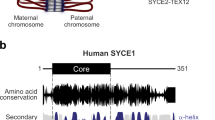Abstract
Synaptonemal complex (SC) analysis of six laboratory yeast strains showed the SC karyotypes to be repeatable within strains. Chromosomal differences were found between strains. In five of the strains, two SCs insert into the nucleolus. This represents a single bivalent with a nucleolar organizer in a medial position as is suggested by genetic data or two bivalents each with a terminal nucleolar organizer. In the first interpretation, n=16; in the second, n=17. Strain Tris has a single nucleolar SC and n=17. In strains DCx374, DCx416 and x 8366a the genetically determined rearrangements of linkage group III could not be identified. Presumably the short SC (0.33 μm) associated with linkage group III cannot accommodate an inversion loop or a translocation configuration. The strains however were found to harbour a reciprocal translocation involving the nucleolar chromosome. Trisomy for one of the longer chromosomes was observed in Tris and spo10. It is concluded that rearrangements of the medium and long but not short yeast chromosomes can be detected cytologically. — Measurements of nuclear volumes show SC length to vary with artifactually induced swelling of the nucleus. Linear regression of SC length over nuclear radius indicates that actual SC length is only about one-half the observed length. As a result the DNA packing per SC unit length is higher then previously estimated.
Similar content being viewed by others
References
Byers B, Goetsch L (1975) Electron microscopic observations on the meiotic karyotype of diploid and tetraploid Saccharomyces cerevisiae. Proc Natl Acad Sci USA 72:5056–5060
Campbell D, Doctor JS, Feuersanger JH, Doolittle MM (1981) Differential mitotic stability of yeast disomes derived from triploid meiosis. Genetics 98:239–255
Carmi P, Holm PB, KoltinY, Rasmussen SW, Sage J, Zickler D (1978) The pachytene karyotype of Schizophyllum commune analyzed by three dimensional reconstruction of synaptonemal complexes. Carlsberg Res Commun 43:117–132
Engels FM, Croes AF (1968) The synaptinemal complex in yeast. Chromosoma 25:104–106
Esposito MS, Esposito RE (1974) Genes controlling meiosis and spore formation in yeast. Genetics 78:215–225
Gillies CB (1972) Reconstruction of the Neurospora crassa pachytene karyotype from serial sections of synaptonemal complexes. Chromosoma 36:119–130
Gillies CB (1973) Ultrastructure analysis of maize pachytene karyotypes by three dimensional reconstruction of the synaptonemal complexes. Chromosoma 43:145–176
Gillies CB (1979) The relationship between synaptonemal complexes, recombination nodules and crossing over in Neurospora crassa bivalents and translocation quadrivalents. Genetics 91:1–17
Gillies CB (1983) Ultrastructural studies of the association of homologous and non-honologous parts of chromosomes in the mid-prophase of meiosis in Zea mays. Maydica 28:265–287
Goetsch L, Byers B (1982) Meiotic cytology of Saccharomyces cerevisiae in protoplast lysates. Mol Gen Genet 187:54–60
Holm PB, Rasmussen SW, Zickler D, Lu BC, Sage J (1981) Chromosome pairing, recombination nodules and chiasma formation in the basidiomycete Coprinus cinereus. Carlsberg Res Commun 46:305–346
Moens PB, Kundu SC (1982) Meiotic arrest and synaptonemal complexes in yeast, ts spo10 (Saccharomyces cerevisiae). Can J Biochem 60:284–289
Moens PB, Moens T (1981) Computer measurements and graphics of three-dimensional cellular ultrastructure. J Ultrastruct Res 75:131–141
Moens PB, Rapport E (1971) Synaptic structures in the nuclei of sporulating yeast, Saccharomyces cerevisiae. J Cell Sci 9:665–677
Mollenhauer HH (1959) Permanganate fixation of plant cells. J Biophys Biochem Cytol 6:431–435
Mortimer RK, Schild D (1980) Genetic map of Saccharomyces cerevisiae. Microbiol Rev 44:519–571
Moses MJ, Poorman PA (1981) Synaptonemal complex analysis of mouse chromosomal rearrangements. II. Synaptic adjustments in a tandem duplication. Chromosoma 81:519–535
Moses MJ, Poorman PA, Rodrick TH, Davidson MT (1982) Synaptonemal complex analysis of mouse chromosomal rearrangements. IV. Synapsis and synaptic adjustment in two paracentric inversions. Chromosoma 84:457–474
Petes TD (1978) Yeast ribosomal DNA genes are located on chromosome XII. Proc Natl Acad. Sci USA 76:410–414
Petes TD (1979) Meiotic mapping of yeast ribosomal deoxyribonucleic acid on chromosome XII. J Bacteriol 138:185–192
Rasmussen SW, Holm PB, Lu BC, Zickler D, Sage J (1981) Synaptonemal complex formation and distribution of recombination nodules in pachytene trivalents of triploid Coprinus cinereus. Carlsberg Res Commun 46:347–360
Rattner JB, Goldsmith M, Hamkalo BA (1980) Chromatin organization during meiotic prophase of Bombyx mori. Chromosoma 79:215–224
Schwartz DC, Cantor CR (1984) Separation of yeast chromosomesized DNAs by pulsed field gradient gel electrophoresis. Cell 37:67–75
Solari AJ (1971) The behaviour of chromosomal axes in Searle's X-autosome translocation. Chromosoma 34:99–112
Tanaka K, Heath B, Moens PB (1982) Karyotype, synaptonemal complexes and possible recombination nodules of the oomycete fungus Saprolegnia. Can J Genet Cytol 24:385–396
Tres LL, Kierszenbaum AL (1981) Meiotic chromosomes of mouse spermatocytes: Identification of bivalents, lampbrush organization, and transcription activities. In: Bioregulators of reproduction. Academic Press pp 229–256
Weith A, Traut W (1980) Synaptonemal complexes with associated chromatin in a moth, Ephestia kuehniella Z. Chromosoma 78:275–291
Zickler D (1977) Development of the synaptonemal complex and the “recombination nodules” during meiotic prophase in the seven bivalents of the fungus Sordaria macrospora Auersw. Chromosoma 61:289–316
Zickler D, Olson LW (1975) The synaptonemal complex and the spindle plaque during meiosis in yeast. Chromosoma 50:1–23
Zickler D, Sage J (1981) Synaptonemal complexes with modified lateral elements in Sordaria humana: Development of and relationship to the “recombination nodules”. Chromosoma 84:305–318
Author information
Authors and Affiliations
Rights and permissions
About this article
Cite this article
Moens, P.B., Ashton, M.L. Synaptonemal complexes of normal and mutant yeast chromosomes (Saccharomyces cerevisiae). Chromosoma 91, 113–120 (1985). https://doi.org/10.1007/BF00294054
Received:
Revised:
Issue Date:
DOI: https://doi.org/10.1007/BF00294054




